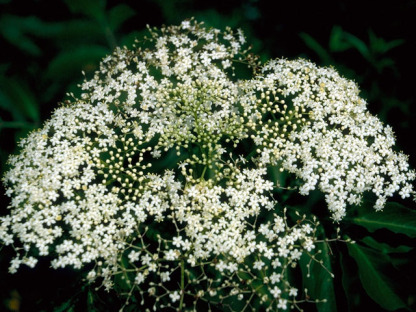
Common Name: Elderberry, Common Elder, American Elder
Full to part sun but tolerates light shade; moderately wet to medium moisture level; almost any soil including coarse sands and gravels, deep loams to fine silts, heavy clays, peats and mucks; slightly acid to neutral pH.
5-12 feet height by 5-12 feet spread; blooms in June and July; creamy white flowers; smooth, globular, purplish-black berries in August and September, usually in broad, drooping flat-topped clusters.
Growth Rate: Fast. Suckers freely to form thickets.
Maintenance: Prune to help curb its spread if needed. Occasional disease problems and infrequent insect problems. Tips of twigs die back regularly. Frequent wind and ice damage in winter.
Propagation: Cuttings root easily. Pre-treat seed 60 days at 68 degrees F. and 90-150 days at 41 degrees F. in moist sand. Without pre-treatment, seed germination can be delayed for 2-5 years after planting.
Native Region: Statewide
Deciduous, open, suckering shrub with warty, arching branches that reach upward and outward. Very large, flat-topped clusters of fragrant flowers produced in profusion. Very adaptable. Best in moist soil but will tolerate dry soils. Older canes lose productivity after several years but are continually replaced with new shoots suckering from the base. Berries are quite edible and can be made into wine, jam, syrup and pies plus entire flower cluster is edible as well. Twigs and fruit can also be used to create dyes for basketry. Very high wildlife value. Attracts birds, butterflies and bees. Cultivars available.




